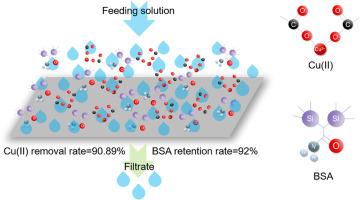Our official English website, www.x-mol.net, welcomes your
feedback! (Note: you will need to create a separate account there.)
Carboxymethylated PVA/PVDF ultrafiltration membrane for removing Cu(II) from water
Polymer ( IF 4.1 ) Pub Date : 2024-11-19 , DOI: 10.1016/j.polymer.2024.127866 Yanwen Chen, Jianguo Xu, Miao Miao, Xueqin Shi, Nana Li
Polymer ( IF 4.1 ) Pub Date : 2024-11-19 , DOI: 10.1016/j.polymer.2024.127866 Yanwen Chen, Jianguo Xu, Miao Miao, Xueqin Shi, Nana Li

|
The ultrafiltration membrane serves to sieve macromolecules but is unable to eliminate heavy metal ions in water, and is prone to be polluted by macromolecules. To achieve the multifunctional and anti-fouling of polyvinylidene fluoride (PVDF) ultrafiltration membrane, we employed the chemical grafting method to synthesize carboxymethyl polyvinyl alcohol (CPVA). Subsequently, we blended CPVA with the PVDF membrane, employing the non-solvent co-induced phase separation (NIPS) method to fabricate the carboxymethylated PVA modified PVDF (CPVA/PVDF) ultrafiltration membrane, which demonstrated significant Cu(II) absorbance capability alongside anti-fouling properties. By observing the sieve-adsorption process, we observed a substantial enhancement in permeate flux, increasing from 1.21 L·m-2·h-1 for the pure PVDF membrane to 53.37 L·m-2·h-1 for the CPVA/PVDF membrane. The static adsorption of the ultrafiltration membrane satisfied the Langmuir and Freundlich isothermal models and followed pseudo-second-order kinetic model. Moreover, the blended membrane effectively removed Bovine Serum Albumin (BSA) and Cu(II) simultaneously, achieving BSA rejection efficiency of 92.00% and Cu(II) removal rate of 90.89%. After 10 cycles of sieving and adsorption, the BSA rejection efficiency remained consistently above 91.00%, while the initial Cu(II) removal rate exceeded 81.00%, indicating excellent reproducibility. In addition to the filtration of BSA, the blended membrane exhibited a low irreversible fouling of 2.59% and a high fouling recovery rate of 97.41%, underscoring its robust anti-fouling properties. The developed sieve-adsorption ultrafiltration membrane lays a solid foundation for the effective treatment of complex wastewater streams.
中文翻译:

用于去除水中 Cu(II) 的羧甲基化 PVA/PVDF 超滤膜
超滤膜用于筛分大分子,但无法消除水中的重金属离子,易受大分子污染。为了实现聚偏二氟乙烯 (PVDF) 超滤膜的多功能和防污,我们采用化学接枝法合成了羧甲基聚乙烯醇 (CPVA)。随后,我们将 CPVA 与 PVDF 膜混合,采用非溶剂共诱导相分离 (NIPS) 方法制造羧甲基化 PVA 改性 PVDF (CPVA/PVDF) 超滤膜,该膜表现出显着的 Cu(II) 吸光度能力和防污性能。通过观察筛子吸附过程,我们观察到渗透通量显著增加,从纯 PVDF 膜的 1.21 L·m-2·h-1 增加到 CPVA/PVDF 膜的 53.37 L·m-2·h-1。超滤膜的静态吸附满足 Langmuir 和 Freundlich 等温模型,并遵循准二级动力学模型。此外,混合膜同时有效去除了牛血清白蛋白 (BSA) 和 Cu(II),实现了 92.00% 的 BSA 截留率和 90.89% 的 Cu(II) 去除率。经过 10 次筛分和吸附循环后,BSA 截留率始终保持在 91.00% 以上,而初始 Cu(II) 去除率超过 81.00%,表现出优异的重现性。除了 BSA 的过滤外,混合膜还表现出 2.59% 的低不可逆污垢和 97.41% 的高污垢回收率,突出了其强大的防污性能。 开发的筛吸附超滤膜为有效处理复杂的废水流奠定了坚实的基础。
更新日期:2024-11-20
中文翻译:

用于去除水中 Cu(II) 的羧甲基化 PVA/PVDF 超滤膜
超滤膜用于筛分大分子,但无法消除水中的重金属离子,易受大分子污染。为了实现聚偏二氟乙烯 (PVDF) 超滤膜的多功能和防污,我们采用化学接枝法合成了羧甲基聚乙烯醇 (CPVA)。随后,我们将 CPVA 与 PVDF 膜混合,采用非溶剂共诱导相分离 (NIPS) 方法制造羧甲基化 PVA 改性 PVDF (CPVA/PVDF) 超滤膜,该膜表现出显着的 Cu(II) 吸光度能力和防污性能。通过观察筛子吸附过程,我们观察到渗透通量显著增加,从纯 PVDF 膜的 1.21 L·m-2·h-1 增加到 CPVA/PVDF 膜的 53.37 L·m-2·h-1。超滤膜的静态吸附满足 Langmuir 和 Freundlich 等温模型,并遵循准二级动力学模型。此外,混合膜同时有效去除了牛血清白蛋白 (BSA) 和 Cu(II),实现了 92.00% 的 BSA 截留率和 90.89% 的 Cu(II) 去除率。经过 10 次筛分和吸附循环后,BSA 截留率始终保持在 91.00% 以上,而初始 Cu(II) 去除率超过 81.00%,表现出优异的重现性。除了 BSA 的过滤外,混合膜还表现出 2.59% 的低不可逆污垢和 97.41% 的高污垢回收率,突出了其强大的防污性能。 开发的筛吸附超滤膜为有效处理复杂的废水流奠定了坚实的基础。


















































 京公网安备 11010802027423号
京公网安备 11010802027423号